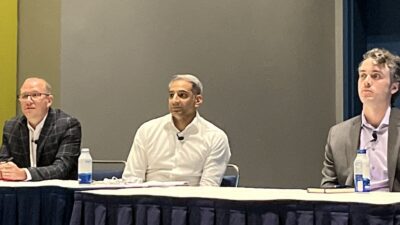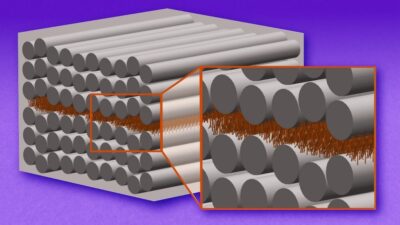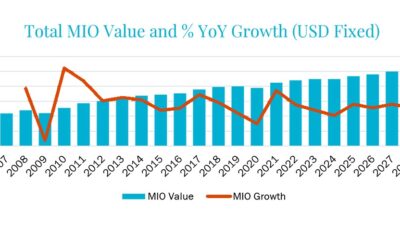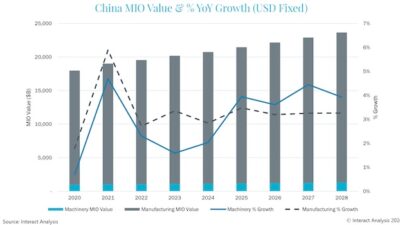Yaskawa Motoman high-speed robots, gateway that allows PLC programming and open programming support, two-arm robots, multi-language support, career fair, and expansion among Automate 2013 announcements.
Robotic announcements at Automate 2013, from Yaskawa Motoman, included a delta robot for high-speed packaging; robots for high-speed material handling, assembly, and packaging; a gateway that enables control and programming through a PLC; Dual-Arm SDA-series robots with 7-axis arms; high-performance robots; multiple language support; a compact robot controller that works with an open software architecture; and laser welding software that improves seam tracking and finding. Corporate announcements include support for students and expansion for drives, motion, and robotics divisions of Yaskawa America Inc. More on each announcement follows.
Yaskawa Motoman high-speed MPP3 Delta robot
The delta-style Motoman MPP3 robot is designed for high-speed picking, packing, cartoning, and kitting applications. Its high-speed operation, 150 cycles per minute, yields extraordinary production results.
The MPP3 robot features a three-arm configuration with a direct-driven rotary axis to increase reliability at high speeds. Its long arms with shorter-arm radii provide a compact footprint and a deeper reach, while providing a large working envelope. The MPP3 robot is IP65 rated and features a 3 kg payload capacity, work envelope of 1300 mm diameter and 500 mm deep, and a repeatability of ±0.1 mm (±0.004 in.).
MPP3 is powered by the FS100 controller featuring a compact footprint and open software architecture for applicability in a wide variety of application arenas.
Motoman MH5, MH5L robots for high-speed material handling, assembly, packaging
Compact and powerful Motoman MH5 and MH5L robots require minimal installation space and offer superior performance in small part handling applications, such as assembly, machine tending, packaging, and dispensing. Internally routed cables and hoses maximize system reliability, reduce interference, and facilitate programming. The 6-axis MH5 and MH5L robots yield extraordinary production results while requiring minimal capital investment.
The MH5 model features a 706 mm (27.8-in.) reach and offers the widest work envelope in its class. When a larger work envelope is required, the MH5L model provides an 895 mm (35.2-in.) reach while maintaining its 5 kg payload capacity. The MH5 and MH5L robots have brakes on all axes and can be floor-, wall-, or ceiling-mounted for layout flexibility. The small footprint and minimal interference radius (179 mm/7-in.) optimizes floor-space utilization.
MH5 and MH5L robots are available with the Motoman DXM100, FS100, and MLX100 Robot Gateway controllers. The DXM100 controller is used for process-intensive applications, and the new smaller FS100 controller is designed for high-speed handling applications. The MLX100 Robot Gateway, designed for assembly and material handling applications, enables the control and programming of Motoman robots directly from the Rockwell Automation ControlLogix platform.
MLX100 Robot Gateway: Control and program through PLC
The Motoman MLX100 Robot Gateway enables control and programming of Motoman robots from the Rockwell Automation ControlLogix platform.
“We are excited about the MLX100 Robot Gateway and what it means for the wider adoption of robotics in the consumer packaging industry,” said Roger Christian, Yaskawa Motoman vice president, marketing and development. “The ability to program the robot from within [Rockwell Automation] RSLogix software opens new possibilities for packaging machine OEMs and end users. Using PAC / PLC language, the MLX100 allows users to program, deploy, and support robotic system solutions utilizing their existing in-house PAC/PLC expertise."
Erik Nieves, technology director, added, “The MLX100 robot gateway is a best-in-class modular architecture that leverages the strength of the Rockwell Programmable Automation Controller (PAC) for logic and control, along with Yaskawa’s advanced kinematics and robot manipulators. The result of our UnifiedControl approach is a scalable system that allows for programming of robots in the Yaskawa family. The power of the MLX100 is not limited to just palletizing robots, but is applicable to packaging robots and even multiple robots on the same controller. The MLX100 brings robotics to any company using [Rockwell Automation] RSLogix 5000 today.”
A multitude of applications are possible on the MLX100 platform, including applications requiring vision guidance and conveyor tracking.
Yaskawa Motoman is a member of the Rockwell Automation PartnerNetwork as an Encompass Product Partner. Christian said, “This partnership continues to broaden our ‘team with the best’ strategy for the benefit of our customers.”
Dual-Arm SDA-Series robots: Next-generation speed, application flexibility
Quick and agile, with “human-like” flexibility of movement, the Motoman Slim Dual Arm (SDA-series) robots provide the reach, payload, speed, performance, and flexibility required to perform a myriad of assembly, handling, machine tending, packaging, and part transfer applications that formerly could be done only by people. SDA-series robots feature 15 axes of motion (7 axes per arm, plus a single axis for base rotation). Internally routed cables and hoses reduce interference and maintenance, and also make programming easier.
Both robot arms can work together on one task to double the payload or handle heavy, unwieldy parts, trays, or pallets. The robot can also lift much more than its payload capacity when using a jib crane or other lift assist device.
The ability to use dual independent arms to process parts reduces the need for expensive custom fixturing and makes end-of-arm tooling simple and less costly. SDA-series dual-arm robots can hold a part with one arm while performing operations on the part with the other arm. Parts can be turned over by a simple hand-to-hand transfer with no need to set the part down or add additional hardware.
The actuator-based design of the SDA-series robots means that the motor, encoder, reducer, and brake for each robot axis are combined into one small, lightweight yet powerful package that is significantly smaller than a traditional ac servo motor drive. Advantages include a slim arm profile, lightweight robot body, and high wrist moment and inertia ratings attractive to service and entertainment applications.
SDA-series robots are available with the new FS100 controller or the DX100 controller. The FS100 is Yaskawa Motoman’s new compact, powerful, and open controller that is designed for small parts handling and assembly applications.
SIA-Series Robots: Lean, powerful 7-axis arms
Motoman Slim Individual Arm (SIA-series) robots feature what the company calls a revolutionary actuator-based 7-axis design, allowing arms to maneuver in very tight areas. Featuring best-in-class wrist performance, these versatile robots open up a wide range of industrial applications and are ideal for nut running, assembly, injection molding, machine tending, and a host of other applications, Motoman said.
Extreme motion flexibility allow these slim manipulators to be positioned out of the normal working area (such as floor-, ceiling-, wall-, incline- or machine-mounted) and reduce floor space requirements.
SIA5, SIA10, and SIA20 models are now compatible with the new FS100 controller. The FS100 is Yaskawa Motoman’s new small, powerful, and open controller that is designed for small parts handling and assembly applications. The FS100 is small enough to be mounted under a conveyor or in other space-saving locations.
At Automate 2013, the SIA10 robot performed collaborative assembly. This new application demonstrates the ability of robots and humans to share space and perform cooperative work in a safe manner and conforms to safety standards.
Motoman HP-Series high-performance robots excel in many applications
With payloads from 20-600 kg, Yaskawa Motoman’s dynamic, high-speed HP-series “High-Performance” robots are extremely versatile manipulators that excel at a wide variety of applications, including welding and machine tending. HP-series robots can also be used for assembly, packaging, palletizing, dispensing, and other tasks. Full six-axis flexibility also allows them to perform complex handling motions and other operations in a multi-function workcell. Heavier-payload models are often used in jigless applications where the HP robot serves as a highly flexible positioner, manipulating the part for processing by up to seven additional robots—all controlled by one Motoman multiple robot controller.
HP-series robots are compact and require minimal installation space. They can be placed close together to reduce overall floor space requirements or placed close to conveyors and other equipment to improve part/product accessibility. HP robots can be floor-, ceiling-, or shelf-mounted to provide highly flexible layouts, and extended-reach versions are available.
HP-series robots are controlled by the Motoman DX100 controller that includes patented multiple robot control technology to easily handle multiple tasks and control up to eight robots (72 axes), I/O devices, and communication protocols. Featuring a robust PC architecture with unmatched memory capacity, the DX100 uses a Microsoft Windows CE programming pendant with color touchscreen. The energy-saving DX100 controller features faster processing speeds for smoother interpolation, advanced robot arm motion, built-in collision avoidance, quicker I/O response, and accelerated Ethernet communication. Its extensive I/O suite includes integral PLC and HMI pendant displays, 2,048 I/O, and a graphical ladder editor that can provide system level control. The DX100 controller supports all major fieldbus networks. It is compliant to ANSI/RIA R15.06-1999 and other relevant ISO and CSA safety standards.
The HP20 robot (20 kg) can also be controlled by the FS100, a compact, powerful, and open software architecture controller.
See next page link below to read about advances in robotic programming, controllers, robotic welding, career development, and Yaskawa expansion, along with more photos.
See previous page link at the bottom to return to the beginning of this article.
Program Yaskawa Motoman robots with ROS Industrial open-source software and NI LabVIEW
A new Yaskawa Motoman Robotics Library (YMRL) for National Instruments LabVIEW 2012 facilitates the programming of Motoman robots into applications using the LabVIEW graphical interface. LabVIEW users can now readily integrate Motoman robots into production or quality control applications.
Support for the ROS-Industrial framework has been expanded to include the FS100 controller. Researchers developing new robotics algorithms or applications can now adopt any Motoman robot into their work.
“Yaskawa Motoman is working to democratize robotics. Historically, the industry approach has been based on proprietary languages. The users were expected to know the robot OEM’s language or learn it,” said Erik Nieves, technology director. “We believe this has stunted the adoption of robotics into new markets. Instead, we continue to introduce new means to program our robots including [Rockwell Automation] RSLogix, [NI] LabVIEW, and ROS Industrial [an open-source industrial robotics package from Southwest Research Institute (SwRI), an independent, nonprofit applied research and development organization. ROS stands for robot operating system.]. These well-established programming frameworks are familiar to users in various markets and will accelerate the growth of robotics into new areas.”
The multiple language approach can be seen performing a variety of new applications at Automate 2013.
Yaskawa Motoman FS100 Controller: Powerful controls, open software, compact package
The new high-performance Yaskawa Motoman FS100 controller is designed with open software architecture and supports PCI Express, C#, C++, .NET, ROS-Industrial, NI LabVIEW, and Motoman INFORM III. The FS100 enables OEMs, machine builders, and integrators to develop their customized software solutions.
"To meet the growing needs of our customers, it is often necessary to create custom functionality for the robot controller. The FS100 design leverages hardware standards and open software to allow easy extensibility of the controls,” said Erik Nieves, Technology Director at Yaskawa Motoman. “It is now possible for users or system integrators to easily integrate off-the-shelf hardware or write value-added functions to the robot controller.”
Designed for packaging, assembly, and material handling applications, the FS100 controller is compatible with Motoman robots with payloads up to 20 kg, including the high-speed MPP3 delta-style robot.
Next-generation Yaskawa Motoman DX100 Controller: Multi-robot, system-level controls
Using patented multiple robot control technology, Yaskawa Motoman’s next-generation DX100 controller easily handles multiple tasks including control of up to eight robots (72 axes), as well as I/O devices and communication protocols. The energy-saving DX100 features faster processing speeds, advanced robot arm control for smoother interpolation, built-in collision avoidance, and quicker I/O response. These advanced control functions take advantage of Yaskawa’s Sigma-5 motor technology to optimize acceleration characteristics and reduce cycle time.
Featuring a robust PC architecture, the DX100 uses a Microsoft Windows CE programming pendant with color touchscreen. Multiple window display capability and a unique cross-shaped navigation cursor reduce teaching time by 30%, and program files can now be up to 32 characters long. A convenient compact flash slot and USB port facilitate memory backups. All operator controls are located on the pendant, allowing the control cabinet to be mounted remotely. Connections to the controller cabinet are made through the back of the unit, optimizing floor space. The space-saving control cabinet allows for up to three external axes and can be remote-mounted. Top- or side-mount expansion options are available. The DX100 conserves power during robot idle time, providing up to 25% energy savings.
Its extensive I/O suite includes integral PLC and HMI pendant displays, 2,048 I/O, and a graphical ladder editor that can provide an efficient system level control. The DX100 supports all major fieldbus networks and offers easy connection to an information infrastructure through standard network options for EtherNet/IP, DeviceNet, Profibus-DP, and others.
The DX100 controller is compliant to ANSI/RIA R15.06-1999, ISO 10218-1-2007, and other relevant safety standards. It includes dual-channel E-Stop functionality, integrated speed monitoring, and manual brake release for the robot. An optional third-party certified Functional Safety Unit provides user-defined zone control and axis limits, plus speed and stopped-state monitoring. By minimizing the robot’s restricted space, these features can be used to reduce the cell floor space requirements.
By often eliminating the need for a separate PLC and human machine interface (HMI), the DX100 controller delivers significant cost savings at the system level, while also decreasing workcell complexity and improving overall reliability.
The DX100 has a reducer status check function that facilitates predictive maintenance. It also provides enhanced troubleshooting and alarm recovery, and a 20% improvement in mean time to repair (MTTR).
Laser seam-tracking and seam-finding software packages enhance welding precision
Yaskawa Motoman MotoEye LT laser seam-tracking and the new MotoEye SF seam-finding software packages are for arc welding applications using Servo-Robot’s laser cameras. MotoEye SF is a high- speed Ethernet interface developed for Servo-Robot’s SF-D laser camera series. This package provides an easy-to-use instruction to read in data from the camera, including joint offset and joint geometry information. This information can be used to adapt the robot weld path and parameters for parts with varying location and fit-up. The seam-finding data can be combined with ComArc through-arc-seam-tracking sensor to provide preview adaptive capability for lower cost than the real-time laser tracking cameras.
MotoEye LT enables Motoman robots to precisely track weld joints at high speeds and in real time, even while the parts are turning on a coordinated positioner. The software provides significant advantages when welding circumferential welds around fuel tanks or similar vessels. Additionally, the software has adaptive capability to vary the weld conditions based on joint gap information from the sensor, resulting in precise, optimized, highly accurate welds.
MotoEye LT has been available for Motoman XRC and NX100 controllers, and has been enhanced for the DX100 controller. This latest version features a high-speed Ethernet interface between the DX100 controller and Servo-Robot’s RoboNet Master camera controller. User-friendly programming menus take advantage of features built into the DX100 controller programming pendant. The Servo-Robot laser cameras are designed to withstand the welding environment and are not affected by ambient lighting or material surface conditions.
Yaskawa Motoman participated in CareerTech Vision 2012
Yaskawa Motoman noted its participation in CareerTech Vision 2012 in Atlanta, Georgia (Nov. 29-Dec. 1, 2012). Together with partners in the Yaskawa Motoman Education Consortium (YMEC), Yaskawa Motoman demonstrated its STEM Robotics Platform, a self-contained portable workcell that is designed to give students hands-on experience with industrial robotics in a classroom setting. (STEM stands for science, technology, engineering, and math.) Erik Nieves, technology director said, "YMEC is focused on making students into work-ready technicians ready for day one on the job."
CareerTech Vision 2012 was designed by the Association for Career and Technical Education (ACTE) to be an integral component of an overall professional learning plan. The format of VISION was created to meet individual professional growth needs and align with institutional strategic-improvement plans. Attendees from across the country and around the world were able to take advantage of a wide range of international partnerships, powerful business and industry connections, and critical certifications.
"CareerTech VISION allowed us to connect directly to technical schools and colleges seeking to add robotics to their curricula," explained Steve Holland, manager of the Motoman Technical Education Center (MTEC).
Yaskawa America Inc. expanded in Brazil
Motoman Robótica do Brasil and Yaskawa Eléctrico do Brasil Ltd., divisions of Yaskawa America, Inc. (YAI), jointly announced their expansion plans in the Sao Paulo area of Brazil. YAI’s parent company, Yaskawa Electric Corporation, said it is the world’s largest manufacturer of ac drives, motion control products, and industrial robots. The two divisions said they have outgrown their current separate facilities and will co-locate to a newly constructed, larger manufacturing campus in Diadema, featuring a 56,000-sq-ft manufacturing space, 38,000-sq-ft office space, and a 6,000-sq-ft training space, for a total space of over 100,000 sq ft, according to the July 2012 announcement. Both divisions will gain increased efficiencies and production capacity through co-locating, but will remain as independent divisions. Both divisions will be fully operational by mid-July. Approximately 150 employees will be located on the new campus.
“With expanded manufacturing and demonstration floor space, new training labs, and additional office space, the new infrastructure will provide even closer cooperation between our two divisions, allowing us to better serve our customers in this growing market,” stated Steve Barhorst, president and COO of Yaskawa America Inc., Motoman Robotics Division.
“The new location will allow us to serve our customers more efficiently while allowing us to collaborate on opportunities between our divisions to offer more solutions to our customers,” added Mike Knapek, president and COO, Drives and Motion Division.
Brazil is one of the fastest growing emerging economies in the world. With significant growth in automotive, agricultural, and mining equipment, in addition to food production and other manufacturing sectors, Brazil’s economy ranks highest among all South American countries with a strong position in global economy.
About Yaskawa Motoman: Founded in 1989, the Motoman Robotics Division of Yaskawa America Inc. said it is a leading robotics company in the Americas. With more than 250,000 Motoman robots installed globally, Yaskawa provides automation products and solutions for virtually every industry and robotic application; including arc welding, assembly, coating, dispensing, material handling, material cutting, material removal, packaging, palletizing, and spot welding.
– Edited by Mark T. Hoske, content manager, CFE Media, Control Engineering, Plant Engineering, and Consulting-Specifying Engineer, [email protected].



